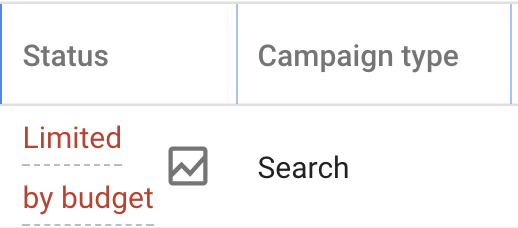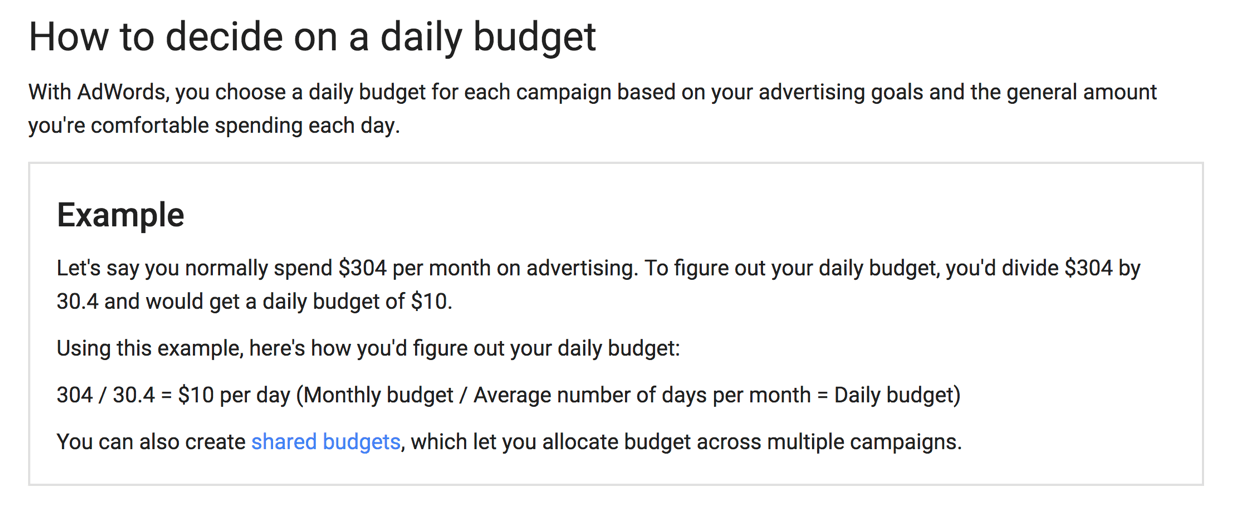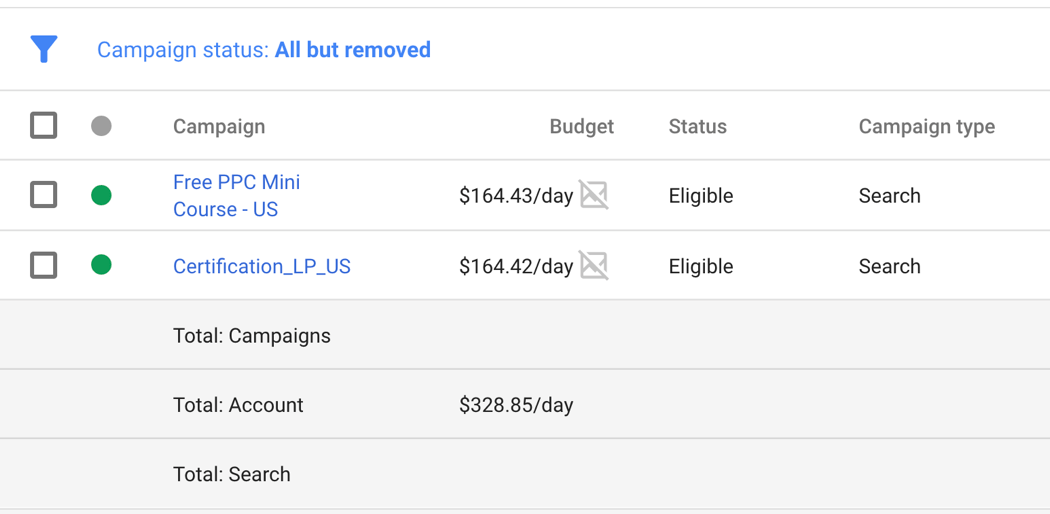Just about anyone who has ever run a campaign in Adwords has seen a “limited by budget” message at some point in time.

You have to hand it to Google, this message is both enticing and dangerous.
Google’s little red “Limited by budget” text on your campaign status taunts you like a shady blackjack dealer.
“Why don’t you double down on that soft hand and get in the game?”
Fortunately, Adwords is not blackjack. We have a lot more options than just raising our budget or standing pat.
But, there is a right way, and wrong way to adjust your AdWords budget.
The good news is we’re going to explain the right way to optimize your budget. I’ll also show you how adjusting your budget the wrong way can cause you to lose money and miss out on conversions.
AdWords limited by budget – What should I do?
One of our PPC Course students recently asked me to help him out with an AdWords limited by budget issue.
This student has a common budget problem that many advertisers face. So, in the post and video below we’ll walk through what to do when our accounts run into budget limitations. I’ll also show you what you need to focus on to adjust your budget correctly.
Monthly vs. daily budgets
Most business look at advertising budgets from a monthly perspective. But AdWords uses a daily system to set your budget.
Calculating your daily AdWords budget
The easiest way to convert your monthly budget to a daily budget is to divide your monthly budget by 30 days.
Google advises that you use 30.4 days to figure out your monthly budget. So, for the sake of playing by Google’s rules, we’ll use 30.4 days in our daily budget calculation.
 Here’s an example of a monthly budget converted to a daily budget for AdWords:
Here’s an example of a monthly budget converted to a daily budget for AdWords:
$10,000/30.4 days = $328.95/day
Splitting your AdWords budget across campaigns
Most Adwords accounts run more than one ad campaign.
Here’s an example of what our account looks like when we split our monthly budget evenly between two campaigns.

Running more than one ad campaigns is an advisable strategy. And it’s the strategy we recommend in PPC Mastery Course. Running multiple campaigns allows you to be more targeted with your advertising. Better targeting make your advertising more efficient.
But, if you’re working on a fixed budget, more ad campaigns means less money for each campaign. As you spread budget across your campaigns, you might find that you quickly run out of money for individual campaigns.
This leads to our “limited by budget” scenario.
PPC Course – limited by budget question
Let’s look at how to fix our budget problem by answering a question from PPC Course Student, Dale.
Dale asks:
In an account there are 2 x campaigns which are each using all of the budget each day with the notice “limited by budget” now being displayed. Due to budget constraints, there is not enough money to fund the campaigns recommended budgets. Would you suggest keep it running as is or putting all of the budget into one of the campaigns and pausing the other?
To answer Dale’s question, we need to focus on the results. Let’s take our two-campaign scenario a few steps further. Using an example will help us see which results hold the answers to our budget problem.
Let’s analyze the two ad campaigns in this example.

Maximizing for clicks?
In the above example, it appears Campaign #1 is significantly outperforming Campaign #2. Campaign number #1 is getting more clicks and has a much lower cost-per-click (CPC).

The CPC data would lead us to believe we should increase the budget for campaign #1.
This is what Google would recommend as well.
Increasing our budget for Campaign #1 is also what Google would advise us to do. Remember, clicks are how Google makes money. Google’s is always going to favor optimizing for clicks.
Focus on the conversions
What If we expand our view of our data, and bring conversions into the picture. As we analyze our conversions and cost per conversion, we start to see very different results.

We can see that Campaign #2 is producing a much better ROI than campaign #1. In fact, Campaign #2 is converting at about half the cost of campaign #1.
Focus on the campaigns that meet your objectives
If we take a limited view of our AdWords data, and only focus on clicks, we can be easily misled by Google.
But when we focus on the data that matters, we can optimize for results that equal income instead of clicks.
There are two keys to managing ad spend across your campaigns.
- Spend more money where you’re getting results.
- If you’re not getting the results you need, optimize and adjust!
In AdWords, you should always make the adjustments that increase your chances of success.
Let’s look at how we could correctly adjust our two-campaign budget and get better results.
Improve your baseline
If we shift the majority of our budget into Campaign #2, and everything else stays the same, our budget becomes more effective.
Here’s why.

Our increased daily budget for Campaign #2 is likely to yield two more conversions at about the same cost – $16.35/conversion.
We’ll lose 2 conversions from Campaign #1 because of the decrease ad spend for that campaign. But we’ll make that up, plus two more conversions, by increasing our ad spend on Campaign #2.
The net difference is 2 additional conversions without increasing our total budget.
Over time, we could shift even more money into campaign #2 if the results stayed consistent.
Win the optimization game
Optimizing for results is how savvy advertisers make their budgets 2X, or even 10X more effective.
Working through our example, we learned a few things.
- The AdWords limited by budget message can be misleading.
- If you act on the “limited by budget” message literally and blindly, you can lose money fast. You can pump money into the wrong campaign, and cost yourself conversions.
- If you do nothing, and don’t optimize your budget for results, you can limit your best ads. Once again you’ll wind up missing out on customers.
No extra budget required
The AdWords limited by budget alert is meaningful. But increasing your budget is not the same thing as optimizing your budget.
In most cases, you can increase your budgets efficiency by adjusting for results, not clicks.
Don’t increase your spending because Google says your budget is too limited.
Adjust.
Increase or decrease your budget based on the results you’re trying to achieve.
This is how optimization works. No magic bullets, just lots of small adjustments leading to major improvements in results.
It’s easy to get sold on software, big data or artificial intelligence being a “rocket fuel” solution for results. But these tools aren’t quite there yet.
The best way to get great results is through small improvements.
Paid search strategies
Using a paid search strategy is one of the best ways help you make decision about you Adwords budget. There are three paid search strategies, and only two are relevant to those hoping to drive a positive short-term ROI. In this article, I share the only paid search strategies you’ll ever need to use.
This post and video was episode 16 in our 90 Day Challenge digital marketing series.
The easiest way to join the 90 day challenge is to subscribe to our YouTube channel. YouTube will send our subscribers weekly emails about all the videos we published over the past week.
Want to know about each video as soon as it comes out? Sign up for 90 day challenge email newsletter. The newsletter will be the best way to make sure you don’t miss any of the content.
